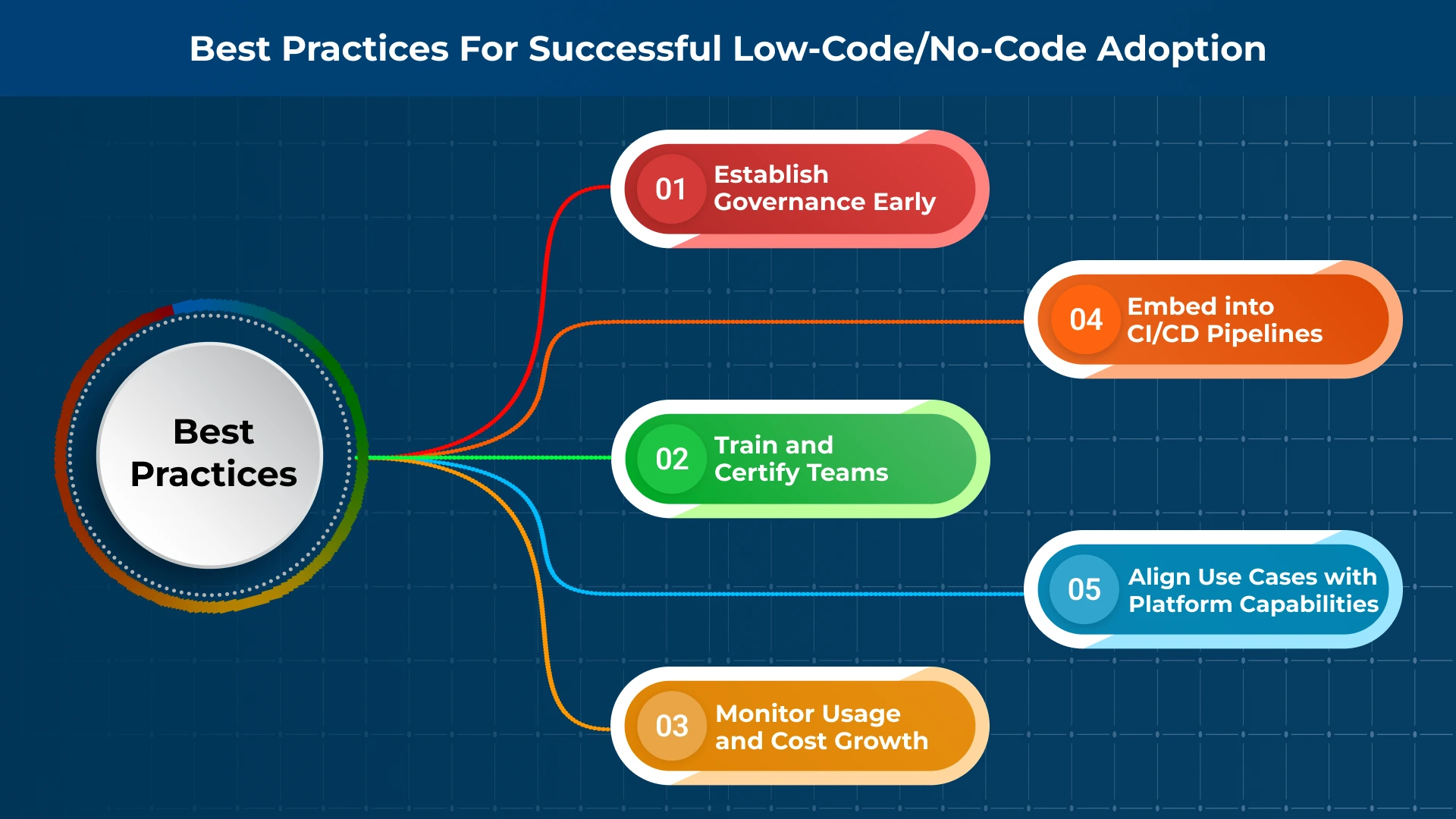
Adopting Low-Code/No-Code Platforms for Rapid Application Development
Enterprise technology teams are now expected to deliver production-ready applications at a speed that traditional development cycles can’t sustain. Agile sprints seem to be shrinking, market demand is rising, and the gap between business needs and engineering capacity is widening.
Low-code and no-code platforms have shifted from departmental prototyping tools into the industrial-level components of a modern software delivery ecosystem. When architected correctly, these platforms integrate with CI/CD pipelines (e.g., Jenkins, GitHub Actions), align with microservices-based backends, comply with security frameworks like SOC 2, GDPR, and ISO 27001, and reduce lead time from business case to production deployment.
For today’s CTOs, the strategic challenge isn’t merely adopting low-code or no-code platforms but embedding them into a hybrid development architecture without compromising scalability, compliance, or maintainability.
What Are Low-Code and No-Code Platforms?
Low-code platforms
To clarify, low-code platforms allow developers to build applications with the help of visual interfaces with less hand-coding. They offer maximum flexibility to extend capabilities using various custom codes where it feels necessary, making them perfect for complex enterprise environments.
Unlike the pure no-code tools, low-code platforms support the custom code injection (JavaScript, C#, or Java ) for having more edge-case logic, which allows software engineering teams to incorporate:
- REST and GraphQL APIs (documented with OpenAPI/Swagger)
- Message queues like Kafka or RabbitMQ for event-driven architecture
- Custom data pipelines built on tools like Apache NiFi or Airflow
Deployment is usually cloud-native, often containerized, and orchestrated by Kubernetes to scale horizontally. Now this makes the low-code extremely suited to the B2B portals, integration hubs, and workflow-heavy internal systems where the extensibility and SLA compliance are much more critical.
No-code platforms
No-code platform takes away the code entirely, allowing non-technical users, analysts, operations managers, and others to configure workflows on their own and then bring apps into action with drag-and-drop tools.
While both of them have their own distinctive features that make them truly unique, the core distinction lies in the customization and audience. Low-code, such as OutSystems, Mendix, Microsoft Power Apps, and Appia, deals with IT teams that need scalability, integration links, and pure authorization. In comparison, no-code solutions such as Bubble, Airtable, and Glide offer an instant deployment of the departmental apps with fewer IT interruptions.
Modern platforms commonly include:
- Visual IDEs with drag-and-drop UI builders
- Reusable components and templates
- Pre-built integrations for CRMs, databases, and SaaS tools
- Workflow automation engines
- APIs and scripting for extensibility (mostly in low-code)
Enterprise-grade no-code adoption requires:
- Governance layers to control data access and prevent shadow IT
- Integration middleware (e.g., Zapier, Workato, or native webhooks) for cross-platform data sync
- Authentication via SAML, OAuth 2.0, or SCIM to ensure compliance with identity standards
- Audit trails to maintain SOC 2 and ISO 27001 readiness
Enterprise-Grade Benefits of Low-Code/No-Code Adoption for Rapid Application Development (RAD)
For technical leaders, the appeal of the low-code platforms isn’t limited to faster delivery; it’s about optimizing engineering resources, incorporating seamlessly into the current infrastructure, and reducing operational risk without compromising compliance or scalability.
1. Accelerated Delivery Cycles Without Sacrificing Quality
An enterprise-ready low-code platform can diminish the lead time from commitment to production by incorporating it directly into CI/CD pipelines such as Jenkins, Azure DevOps, and GitHub Actions. What once took nearly two months can now be delivered within three to six weeks with the help of automation, containerized builds, and controlled release management.
2. Optimized Developer Utilization
By offloading the CRUD-heavy UI, form management, and workflow automation to the low-code tools, the engineering teams can focus more on the high-end infrastructure, distributed systems, data leaks, and real-time analytics.
3. Reduction of Backlog and Shadow IT
Assessed no-code adoption lets the business units deploy the internal solutions under IT’s security umbrella. This reduces the risk of unsanctioned SaaS usage while still enabling agile departmental innovation.
4. Integration Alignment with Enterprise Systems
Modern platforms are equipped with standard native connectors for the ERP (SAP), CRM (Salesforce, Dynamics 365), and other cloud data warehouses (Snowflake, BigQuery).
For the systems without native connectors, REST / GraphQL endpoints or event streaming via Kafka help to incorporate without having middleware.
5. Cost Efficiency Through Hybrid Development
- Reduced OPEX: Small-scale delivery teams with faster cycles and low infrastructure, which gives a decent provisioning cost.
- Licensing ROI: Consolidating multiple tools into a single low-code platform can reduce the software sprawl.
- TCO Visibility: The enterprise-grade assistance integrates with the low-code workloads, ensuring that the performance SLAs and cost tracking are met.
When to Consider Low-Code/No-Code for Rapid Application Development (RAD)
Rapid Application Development is more focused on fast prototyping, iterative delivery, and feedback, which comes directly from an ongoing user. It works optimally well when the responsiveness and the replication outweigh the perfection on the initial release.Ideal use cases include:
1. Internal Operations Tools
From getting approval for the apps to managing the asset dashboard, internal tools can be quickly made using low-code platforms and maintained without any infrastructure overhead.
2. Customer and Partner Portals
Building a customer onboarding portal via OutSystems with Azure AD B2C integration, backed by a PostgreSQL data store, deployed in a Kubernetes cluster behind an API Gateway, with real-time event publishing to Kafka for downstream analytics.
3. Proof-of-Concepts and MVPs
Product teams validating new features or markets can use no-code tools for functional prototypes, gathering user feedback before investing in scalable engineering.
4. Workflow Automation and Integrations
Automating data movement across tools (e.g., from Salesforce to SAP to Outlook) using visual workflow builders reduces manual effort and speeds process modernization.
Best Practices for Successful Low-Code/No-Code Adoption

1. Align Use Cases with Platform Capabilities
Map platform strengths to workload profiles:
- Low-Code: Integration-heavy, extensibility required, high-volume transactions.
- No-Code: Lightweight workflows, departmental apps, rapid POCs.
2. Establish Governance Early
- Define RBAC/ABAC policies.
- Apply version control (Git) for low-code assets.
- Maintain audit logs for compliance (SOC 2, ISO 27001).
3. Train and Certify Teams
Enable citizen developers while enforcing secure coding practices. Provide certifications for both IT staff and business users.
4. Embed into CI/CD Pipelines
- Integrate with automated testing suites (Selenium, Postman).
- Enable containerized deployments (Docker, Kubernetes).
- Use Infrastructure as Code (Terraform, Pulumi) for environment consistency.
5. Monitor Usage and Cost Growth
- Track API call volumes and concurrency limits.
- Audit licensing usage quarterly to prevent unexpected cost spikes.
Challenges and Limitations of Low-Code No-Code Platforms
Even mature low-code and no-code platforms come with certain limitations that an enterprise team must acknowledge and address right away.
1. Vendor Lock-In
Proprietary data models and scripting languages can make migration difficult. Evaluate the long-term flexibility of the platform and the availability of export tools or open standards.
2. Scalability and Performance Limits
For applications requiring low latency or complex data processing, platform performance can become a constraint. Load testing and API limits should be understood up front.
3. Security and Compliance Risks
Allowing non-developers to build apps introduces security and compliance risk. Without strict controls, you risk data leakage, audit failure, or compliance violations.
Why This Distinction Matters for Technical Leaders
For CTOs and CIOs, the decision between low-code and no-code is not about who makes the app, but about how the app integrates into the current enterprise infrastructure.
A low-code deployment can be more of a microservice with a larger service mesh, interact with the core APIs, and maintain CI/CD compatibility with traditional development.
A no-code app, while it may be faster to deploy, still needs architectural isolation via VPCs, API sensing, and middleware to avoid any potential threats and risks.
How Telliant Systems Brings the Solution
With the level of expertise in enterprise DevOps, security frameworks, and cloud architecture, we enable the low-code and no-code adoption, which delivers speed without compromising control. Here at Telliant Systems, we work closely with the CTOs and the CIOs to incorporate these platforms into a modern, cloud-native architecture, which ensures:
- Seamless integration with your API, data, and identity layers.
- Governance controls are used to maintain compliance and security posture.
- Performance optimization to meet SLA and scalability targets.
Conclusion
At Telliant Systems, we help CTOs and software leaders embed these platforms into their software delivery ecosystems. From platform evaluation and governance frameworks to enterprise-grade implementation and developer enablement, we ensure low-code solutions integrate seamlessly into your architectural blueprint, delivering speed without compromising control.






































